Birthplace of Gospel, Adler’s Final Masterpiece: Ebenezer Missionary Baptist Church
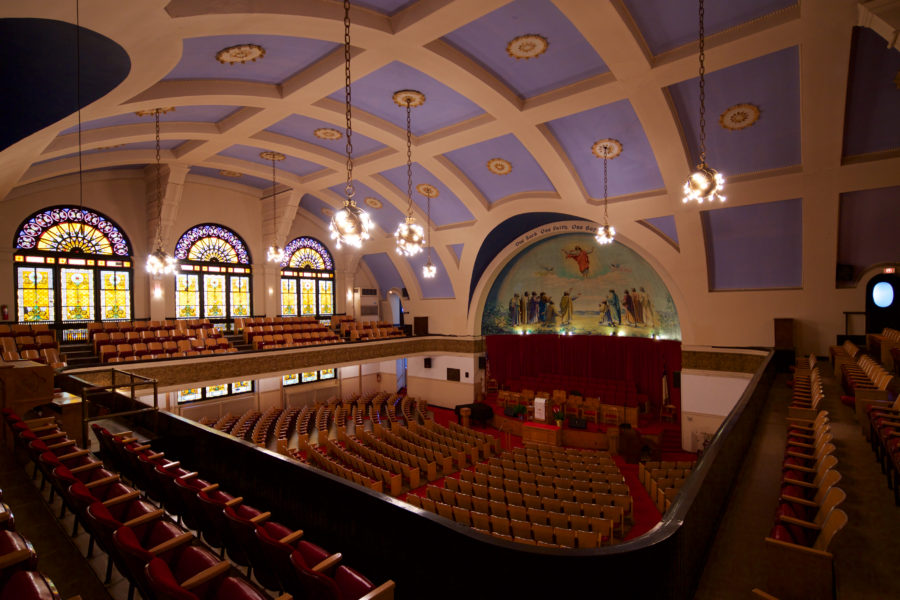
Ebenezer Baptist Interior. John Morris/Chicago Patterns
A cultural treasure resides at 45th and Vincennes in Bronzeville: Ebenezer Missionary Baptist Church. This church (and former synagogue) represents a grand alpha and omega: the birthplace of gospel music and the final work of legendary architect Dankmar Adler.

Dedication announcement featuring drawing by Dankmar Adler. From Chicago Daily Tribune, March 11, 1899.
Early Life as Isaiah Temple
Before it was the Ebenezer Missionary Baptist Church, the building was a place of worship for what was originally known as Isaiah Congregation, formed in 1895.
A few years afterward, the congregation purchased land at 45th and Vincennes for a new synagogue, later known as Isaiah Temple.

Glass window panel from Adler & Sullivan’s firm. Image courtesy of the Richard Nickel Committee
The Start of Adler & Sullivan
Dankmar Adler, the building’s designer, is best known for his partnership with Louis Sullivan at the firm of Adler & Sullivan.
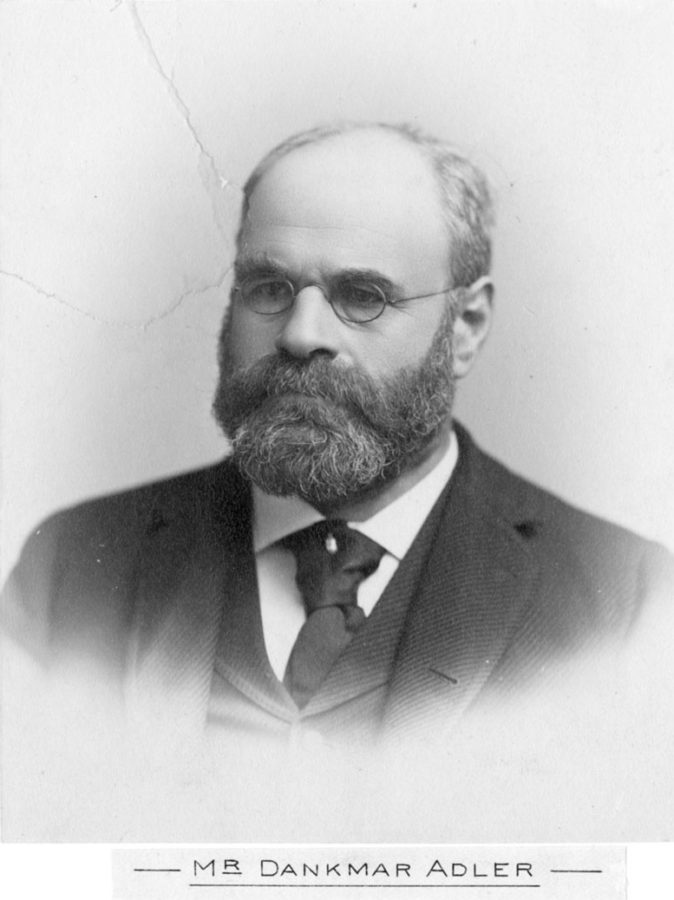
Dankmar Adler, World’s Columbian Exposition, c. 1891. Ryerson and Burnham Libraries Book Collection, Ryerson and Burnham Archives, The Art Institute of Chicago.
Adler was born in Eisenach, Germany, in 1844. His name is a compound word for dank (thanks) and mar (bitter), given by his father reflecting the bittersweet story of Dankmar’s birth. His mother died while giving birth.
After failing to get accepted into college, he received private instruction in drawing. With the help of his father, he later became an apprentice for John Schaeffer, a well-known architect. The apprenticeship was cut short by the Civil War, when he enlisted in Company M, First Regiment, of the Illinois Light Artillery.
Adler served between 1862 and 1864. He managed to spend much of his time reading science and engineering books–furthering his education during wartime.
After his service, he returned to Chicago and eventually started his own firm in 1879. Not long after, he hired Louis Sullivan, who quickly became a full-fledged partner of the firm.

Announcing the new Auditorium Building, Chicago Inter Ocean, July 10, 1887
Together, they designed the Auditorium Building, among many other important structures. The firm’s work created garnered nationwide publicity, as documented in this Inter Ocean article from 1887:
The greatest private building enterprise ever undertaken in this country is now in progress in the city of Chicago–a city which this year celebrates its fiftieth anniversary […]. The colossal structure, of which an engraving is presented on another page, massive and imposing as it appears, is less expressive of progress in architecture than of the march of empire.
Chicago Inter Ocean, July 10, 1887
Their partnership resulted in some of the finest examples of architecture that exists. The firm’s design of theaters and auditoriums also had the finest acoustic engineering of the era.
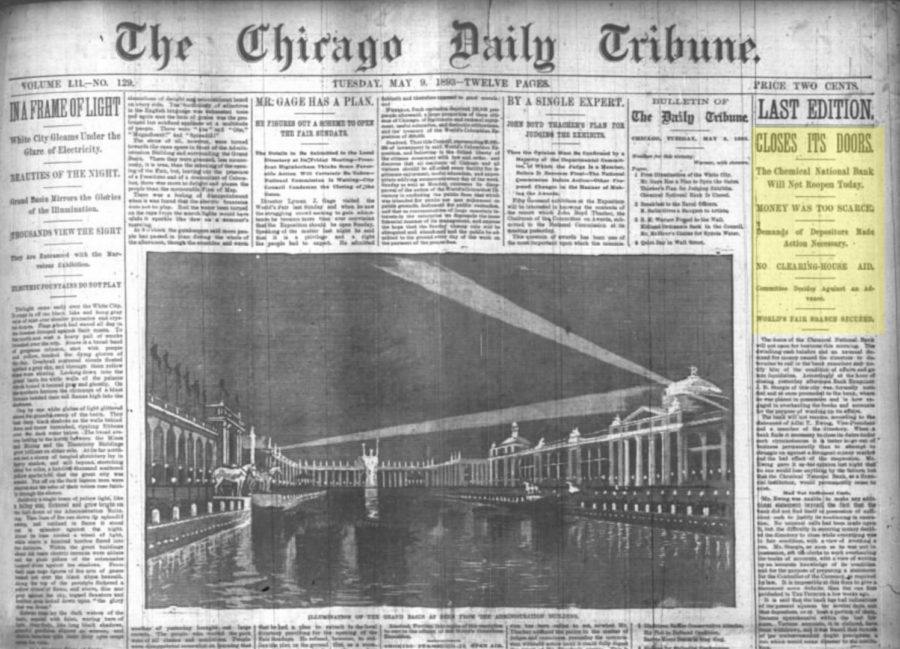
May 9, 1893, issue of Chicago Daily Tribune. Top left story reads: “IN A FRAME OF LIGHT / White City Gleams Under the Glare of Electricity.” Right story reports on the failures of Chemical National Bank, which kicked off the Panic of 1893.
The Panic of 1893
Adler & Sullivan’s success–unprecedented for nearly 15 years–began to unravel when the Panic of 1893 struck.
The heady days ushered in by the World’s Columbian Exposition came to an end as a result of shoddy banking practices. The bank associated with the Fair, Chemical National Bank, failed. There were runs on banks large and small across Illinois. The Fair was dealt a hard blow.
As a result, Adler & Sullivan’s staff was trimmed, going from more than 50 people down to the firm’s principals: Adler and Sullivan.
The End of Adler & Sullivan
Worried about his family’s financial well-being and the firm’s lack of new clients, Adler took an engineering position with an elevator company that paid a yearly salary that was more than he had ever earned with his own firm. The economic crisis split apart one of the most important architecture partnerships that had ever existed.
However, the new stint didn’t last long.
Historical records offer few details, but Adler unsuccessfully tried to renew the former partnership. He began work with his own firm in partnership with his son–in an office in the auditorium building where Sullivan also worked.
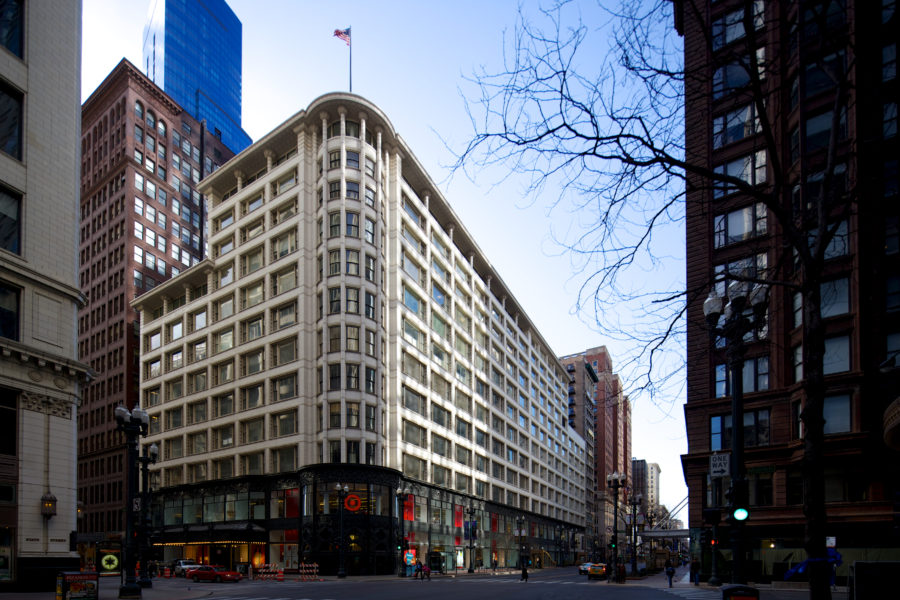
Carson, Pirie, Scott and Company Building. John Morris/Chicago Patterns
Despite the common perception of a bitter or non-speaking relationship following the end of the firm, the two men remained in personal contact and even collaborated on a few more projects.
Adler provided engineering designs for the Carson, Pirie, Scott and Company Building (above) to Sullivan, after the dissolution of their firm. To this day, Dankmar Adler rarely, if ever, receives enough credit for his contribution to this National Historic Landmark.
Primarily an Auditorium, then a Building
Adler was primarily an engineer (structural and acoustic), and it is evident when considering Ebenezer Missionary Baptist Church. His inspiration for acoustic perfection may have been inspired by his father’s profession as a rabbi. The importance of carried sounds throughout the house of worship was paramount.
In Emily Ann Thompson’s book The Soundscape of Modernity, Sullivan is quoted describing Adler’s intuitive expertise:
It was not a matter of mathematics, not a matter of science. There is a feeling, perception, instinct and that Mr. Adler had. Mr. Adler had a grasp of the subject of acoustics which he could not have gained from study, for it was not in books. He must have gotten it by feeling.
—Louis Sullivan, describing Adler’s acoustic intuition
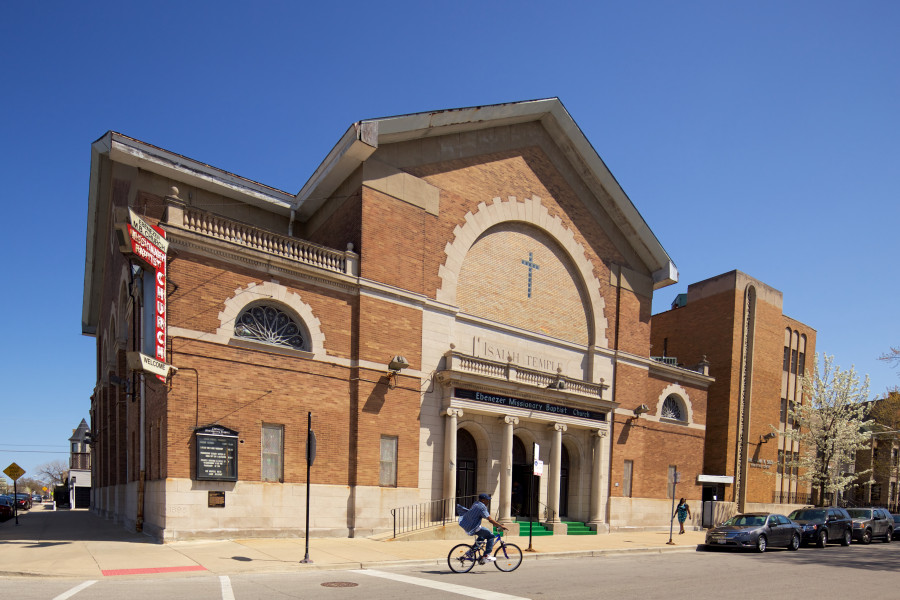
Ebenezer Church exterior. John Morris/Chicago Patterns
The exterior of the building is a slightly modified version of Classical Revival, without the geometric ornament frequently seen on the buildings he co-designed with Sullivan.
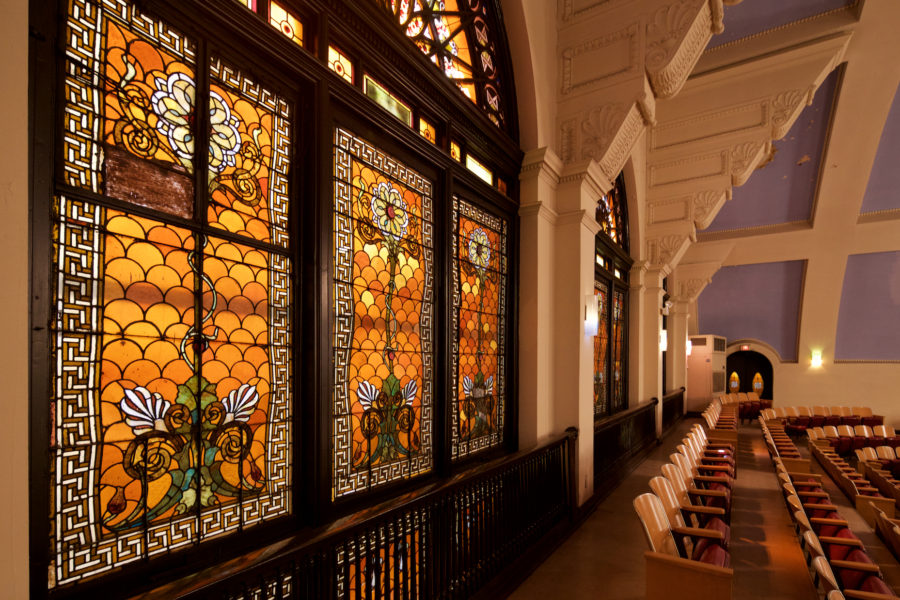
Interior view of geometric patterned windows. John Morris/Chicago Patterns
The opalescent leaded glass windows feature sunburst patterns, a clear influence from Sullivan’s geometric ornament.
Adler’s Response to ‘Form [Ever] Follows Function’
Despite taking design cues from Sullivan in his solo practice, Adler differed with him in some aspects. In 1896, he penned a response to Sullivan’s famous essay which expressed the “form [ever] follows function” mantra, which even today frames debates about architecture:
… if ‘form follows function,‘ it does not follow in a straight line, nor in accordance with a simple mathematical formula, but along the lines of curves whose elements are always changing and never alike; and if the lines of development and growth of the vegetable and animal organisms are infinitely differentiated, the process of untrammeled human thought and human emotions are even more subtle in the differences and shadings of their manifestations. Before accepting Mr. Sullivan’s statement of the underlying law upon which all good architectural design and all true architectural style is founded, it may be well to amend it and say: ‘Function and environment determine form,’ using the words environment and form in their broadest sense.
–Dankmar Adler, 1896
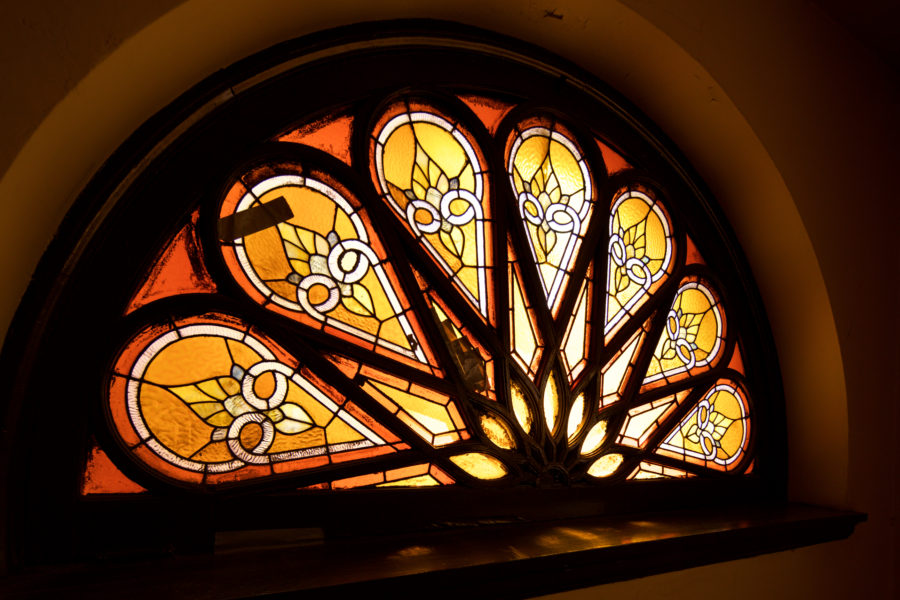
Stained glass mullion patterns. John Morris/Chicago Patterns
In the case of Isaiah Temple (known today as Ebenezer MB Church), it’s possible the ‘environment’ was the client or congregation. Rather than the Moorish or other Far-East styles common among synagogue construction at the time, Isaiah Temple picked a more Mediterranean-styled inspiration, closer to the palaces and houses of worship of Greece and Roman cultures.

No obstructions or obstacles for sound to reach the audience. John Morris/Chicago Patterns
Furthermore, the exterior design follows the essence (the impressive, grand auditorium) of the building. There are no obstructions between the audience and the speaker. Every square inch of interior space appears to serve a purpose relating to acoustic engineering.
This auditorium’s design would eventually help make the sounds of gospel music soar to heavenly highs.
Adler’s Final Triumph
Temple Isaiah’s construction completed in 1899. A year later, Dankmar Adler died. The temple was his last project. It still stands as one of only three surviving auditorium buildings he designed.
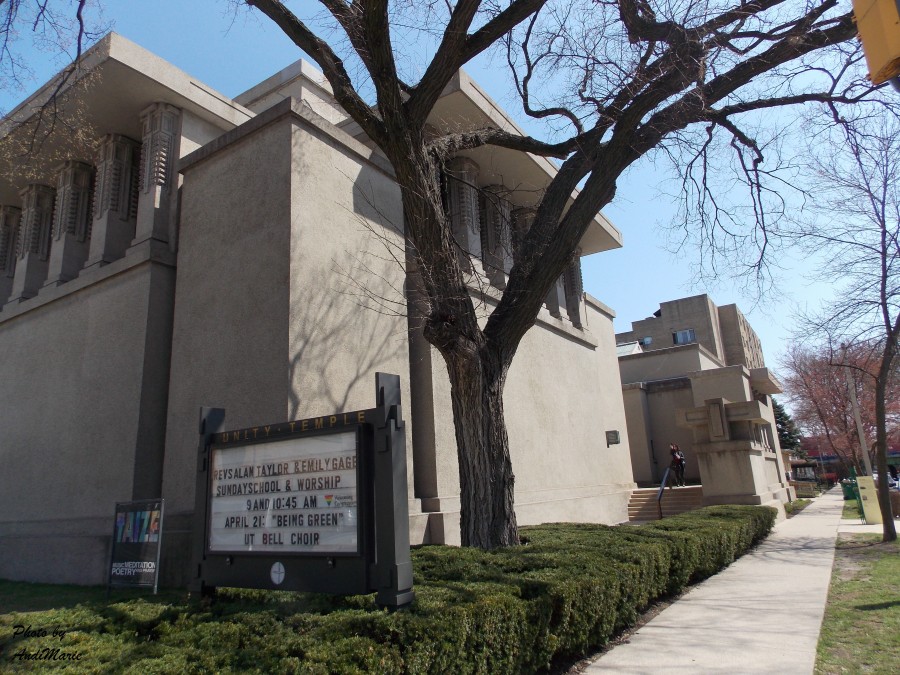
Unity Temple, said to have been influenced by Isaiah Temple. Andi Marie/Chicago Patterns
Classicist Influence on Frank Lloyd Wright
Adler’s aesthetic would provide some inspiration to Frank Lloyd Wright, who was once a draftsman at the Adler & Sullivan firm.
According to historian Joseph Siry, Isaiah Temple shows a clear influence on Wright’s Unity Temple in Oak Park.
Four Congregations Become One
Historian and photographer Frederick Nachman notes in his article Four Congregations Become One that Isaiah Temple sold the building to Ebenezer Missionary Baptist Church in 1921:
As the 1920s approached, the reform congregations began various merger discussions. In 1921, Isaiah Temple sold its building to the Ebenezer Missionary Baptist Church and began construction on a new synagogue on S. Greenwood Ave. and E. Hyde Park Blvd. The Byzantine-style structure was also designed by Alfred Alschuler and was completed in 1924. Shortly thereafter, B’nai Sholom Temple Israel merged with Isaiah Temple to form Temple Isaiah Israel.
Without a merger partner, KAM sold its building to the Pilgrim Baptist Church and moved into a large Greek-revival temple at S. Drexel Blvd. and E. 50th St. in 1923. It did not move north and east to merge with Temple Isaiah Israel until 1971, forming what is now KAM Isaiah Israel.
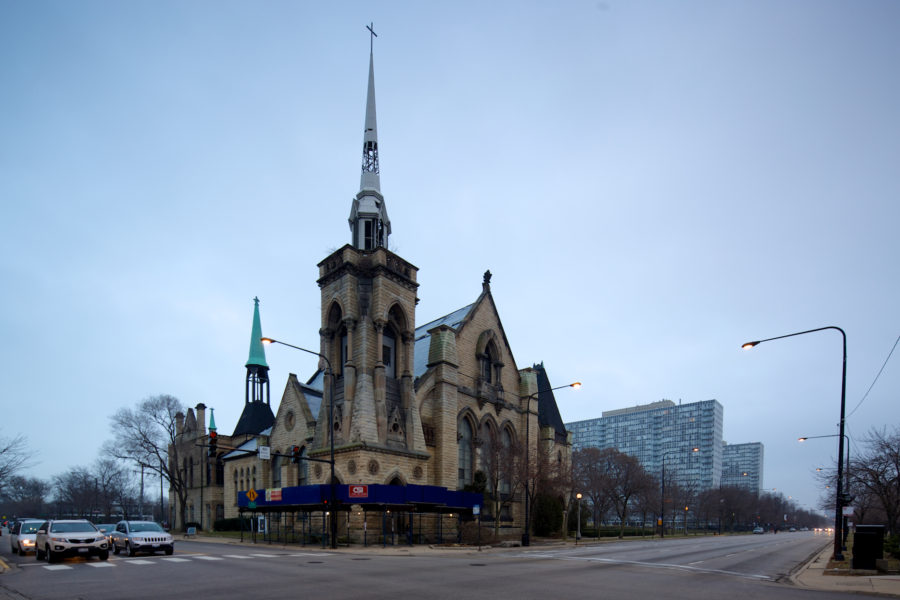
Olivet Baptist Church has been at 31st and King Drive since 1907. John Morris/Chicago Patterns
Ebenezer’s Origins to Olivet Baptist
Ebenezer Missionary Baptist Church began 1902 with a congregation of 30 members who had split from Olivet Baptist Church (current location pictured above). Olivet Baptist Church was founded in 1862 and is the oldest African-American church in Chicago. Rev. John Francis Thomas led the new congregation at Ebenezer Missionary Baptist Church.
Founding Based on Serving the Community
Ebenezer was founded as not only as a place of worship but a resource for those in need. The City of Chicago Landmark Designation report notes that in 1914, the church provided meals to the city’s hungry each day for month during the winter:
On February 7, 1914, the Chicago Defender reported that the church had fed 4,327 individuals, with “whites outnumbering all other races by 20 to 1.” Even as some white congregations refused to serve African Americans, Rev. Thomas stressed that at Ebenezer, “none was turned away,” and that there is “no color line in heaven.”
Neighborhood Transition and Growth as a Result of the Great Migration
World War I created a series of events that led to the Great Migration. The war halted immigration even as it increased demand for manufactured goods and the labor to produce it.
In light of this demand, factories opened their doors to African-Americans. The promise of wages and escape from persecution in the South led to a massive influx to Chicago.
A New Building for a Growing Congregation
The dramatic demographic change led to a much larger congregation for Ebenezer Missionary Baptist, which reached nearly 2,000 people around 1920.
Almost 20 years after its founding, Rev. Thomas led efforts to find a new home for the growing congregation. In 1921, he began negotiations to purchase the building from Temple Isaiah. He died later that year.
A Period of Turmoil
Rev. Charles H. Clark, a minister in Nashville, was tapped to lead the congregation after Thomas’ passing. He led for ten years, growing the flock to more than 3,000 and paid off the mortgage on the new building ahead of schedule. But by summer 1930, rumors and grumblings concerning his salary and personal life.
After a few dramatic public events, Clark resigned, leading to the arrival in 1931 of Rev. Dr. James Howard Lorenzo Smith of Tabernacle Baptist Church in Birmingham, Alabama.
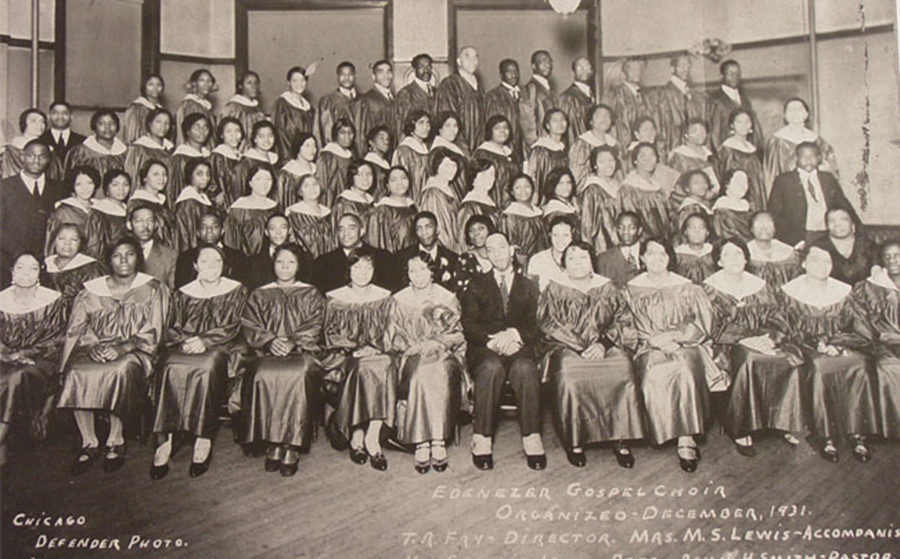
The first gospel choir at Ebenezer in 1931. Photo courtesy wttw.
A New Pastor and a New Sound
Rev. Smith found the church’s existing services out of step with the lively sermons he was accustomed to in the South. He sought a revival of sorts for the church following its period of discord:
On December 6, 1931, he preached to his congregation about a vision he had received. Rev. Smith’s vision was of a choir of Christian men and women sitting behind him singing what he called, “Good old-fashioned songs sung by our forefathers down in the southland.” In this sermon, Rev. Smith gave the call for the organization of the first gospel chorus.
Rev. Smith put together a team of music innovators to direct the chorus. He called upon professor Theodore Frye as director and professor Thomas A. Dorsey as pianist. In January 1932, after only a month of rehearsals, the Ebenezer gospel chorus made its debut in a church filled to capacity. The 100-member chorus wowed the congregation with their soulful Southern-influenced spiritual sound.
— Vivian G. Harsh Research Collection of Afro-American History and Literature, Chicago Public Library

Pilgrim Baptist Church, originally built as Kehilath Anshe Ma’ariv Synagogue by Adler & Sullivan. Ryerson and Burnham Libraries Book Collection, Ryerson and Burnham Archives, The Art Institute of Chicago.
Dorsey Leaves Ebenezer for Pilgrim Baptist
Just a few weeks after this, however, Thomas Dorsey, the pianist, left Ebenezer to lead a new gospel choir at Pilgrim Baptist Church (above), accepting an offer from its pastor, J.C. Austin. The reasons for this sudden change were explored in Wallace D. Best’s book, Passionately Human, No Less Divine: Religion and Culture in Black Chicago, 1915-1952.
It’s noted that Dorsey’s reason for leaving wasn’t entirely clear. He didn’t leave for financial reasons, (Dorsey stated “it wasn’t paying nothin‘”) or for prestige, something he already possessed as being the first and only gospel choir leader in Chicago.
Whatever the motivation, Dorsey accepted the position and Pilgrim Baptist – not Ebenezer – became known as the birthplace of gospel music.
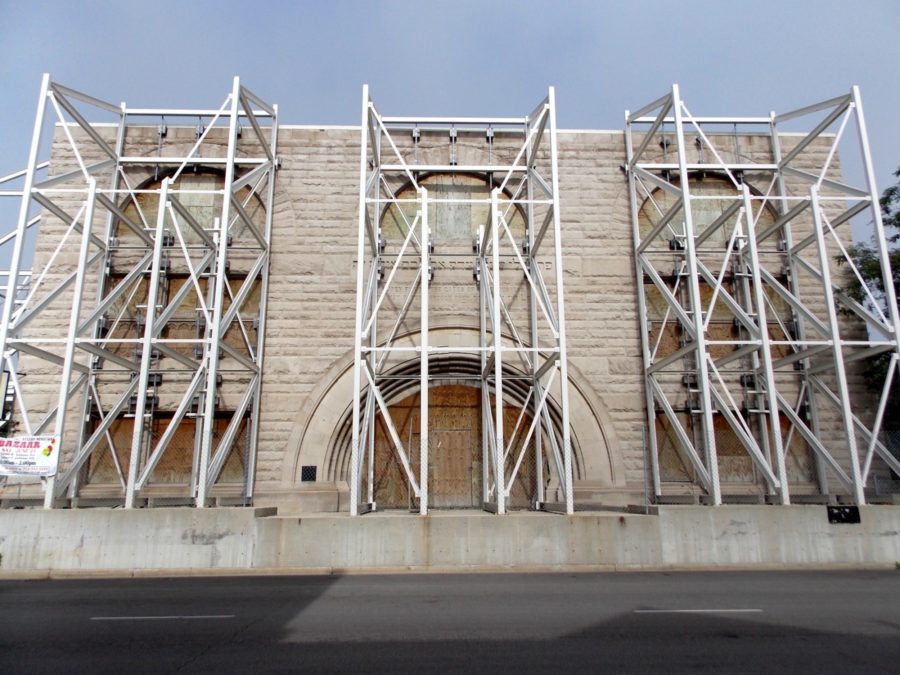
What remains today of the original Pilgrim Baptist Church building, destroyed by fire in 2006. Andi Marie/Chicago Patterns
Coincidentally (or not), this building also shared the acoustic quality of Ebenezer Baptist Church. Pilgrim Baptist Church’s building was designed by Adler & Sullivan, and sadly, was destroyed by fire in 2006.
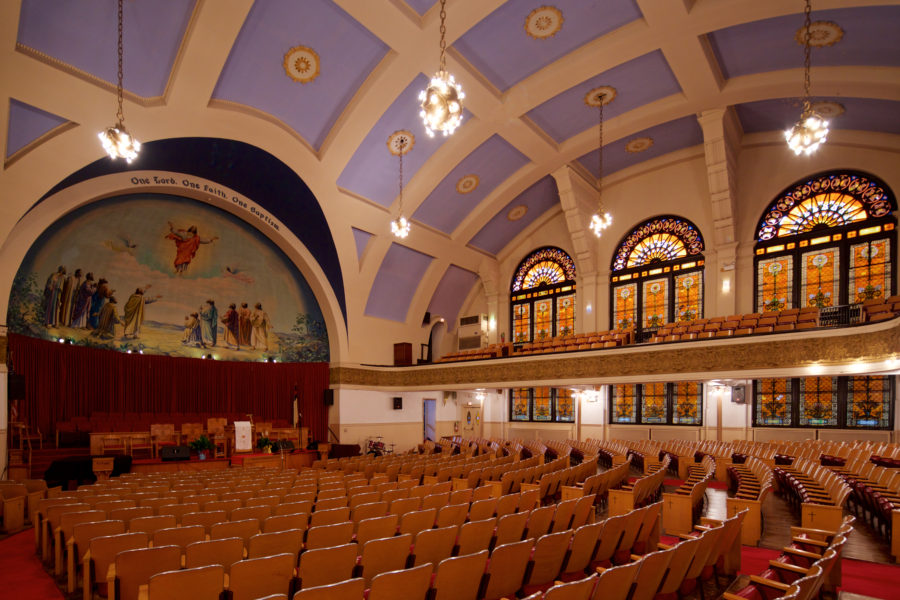
John Morris/Chicago Patterns
Ebenezer Baptist Today
Ebenezer is led by Rev. Marcel Kerr. His bio on the church’s site talks about how his background of growing up on the South Side shaped his life and spiritual views:
I have no shame telling people I grew up in Englewood. That neighborhood is well-known for its violence and poverty, but people with strong values can survive and thrive. The Lord blessed me with an incredible family structure who would not allow me to become a victim of the streets. My parents set a high standard for academic achievement, and they wouldn’t compromise. Anything short of excellence simply was not tolerated.
–Rev. Kerr
He received a journalism degree from Northwestern University a Masters in Divinity from Northern Baptist Seminary in Lombard.
Total PraiseEbenezer celebrates its Chicago Landmark Status, singing ‘Total Praise” in June 2012
Posted by The Birthplace of Gospel Music on Saturday, May 30, 2015
2012: Landmark Status
In 2012, Ebenezer received landmark status from the city. In the video above, members are singing in celebration of that designation. You can find that video and more through the church’s Facebook page, The Birthplace of Gospel Music.

Repeating bands of the Star of David. John Morris/Chicago Patterns
Two Ways to Visit this Architectural Wonder
To experience this architectural and acoustic wonder, you can attend its morning services.
The church is also a regular participant in Open House Chicago, an annual fall event in which hundreds of buildings throughout the city are open for the public to tour.
Ebenezer Missionary Baptist is a place you should visit–it’s a living thread connecting many priceless cultural treasures.
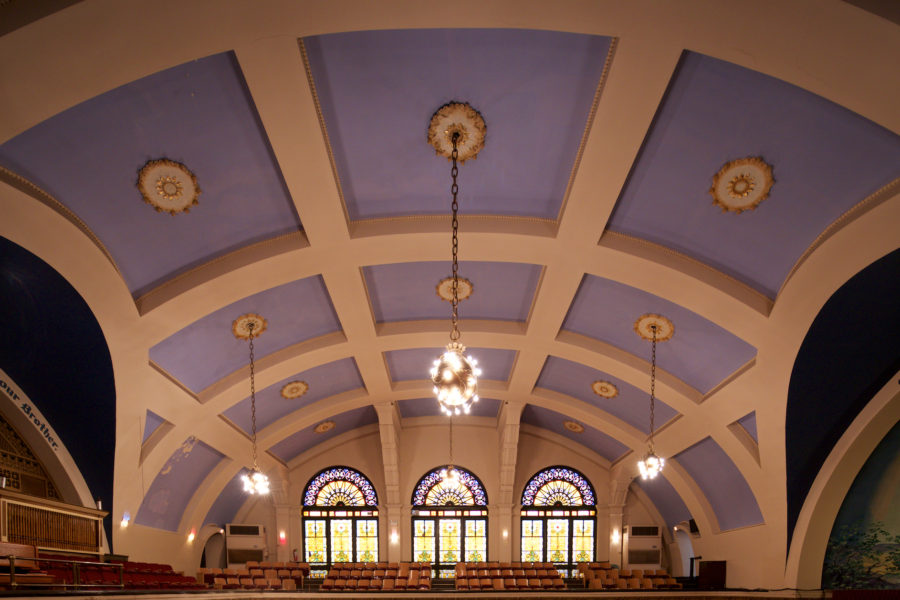
John Morris/Chicago Patterns
Related Articles
- Pilgrim Baptist Church and Kehilath Anshe Ma’ariv Synagogue (Andi Marie/Chicago Patterns)
- Subtle Fractal Geometry in Wright’s Roloson Row Houses (John Morris/Chicago Patterns)
- Chicago Bee: Cornerstone of the Black Metropolis (John Morris/Chicago Patterns)
References and Further Reading
- Adler and Sullivan (Chicago History Museum)
- Dankmar Adler (Jewish Virtual Library)
- Landmark Designation Report, Ebenezer Missionary Baptist Church (City of Chicago, PDF)
- The Soundscape of Modernity (Emily Thomas/The MIT Press (September 17, 2004))
- A City Called Heaven: Chicago and the Birth of Gospel Music (Robert M. Marovich/University of Illinois Press (March 3, 2015))
- Ebenezer Missionary Baptist Church Archives (Vivian G. Harsh Research Collection of Afro-American History and Literature, Chicago Public Library)
- Ebenezer Missionary Baptist Church (official site)


Excellent John! I have to visit this historic sacred space.
You should! So much history and beautiful architecture in one place.
Sorry I didn’t get a chance to get back to you, John, but you have captured the essence of Ebenezer very well! It is certainly a site worth visiting.
Thank you for the kind words, Patricia. And thank you again for the tour and history of your wonderful church.
Wonderful information about my home church. My family was life long members there. I grew up playing the pipe organ at Ebenezer.
Richard
I grew up in Ebenezer Baptist Church and was also baptized by Rev Cage. I was also married there by the Late Frank K. Sims in 1975. My grandmother was the church historian the Late Asalein E. Lowery. My mother was also baptized at Ebenezer the Late LeVergne M Miller). It has numerous memories for my entire family.
I am overwhelmed with emotion about the church of my youth. This is the church that was instrumental in my spiritual development. I owe Ebenezer and its people so much! I am humbled that the providence of God has lead me back to this great church to serve as its 9th Pastor.